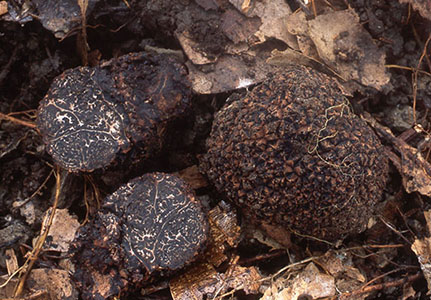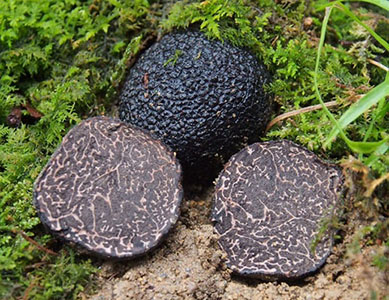Home > Research > Research Results > Research Results 2018 > Two kinds of black truffles that could be used as food materials in Japan
Update:June 5, 2018
Main content starts here.
Two kinds of black truffles that could be used as food materials in Japan
| Article title |
Using mating-type loci to improve taxonomy of the Tuber indicum complex, and discovery of a new species, T. longispinosum |
|---|---|
| Author (affiliation) |
Akihiko Kinoshita (a), Kazuhide Nara (b), Hiromi Sasaki (c), Bang Feng (d), Keisuke Obase (e), Zhu L Yang (d), Takashi Yamanaka (f) (a) Kyushu Research Center, FFPRI, Kumamoto, Japan. (c) Mycologist Circle of Japan, Fujisawa, Kanagawa, Japan. (d) Key Laboratory for Plant Diversity and Biogeography of East Asia, Kunming Institute of Botany, Chinese Academy of Sciences, Yunnan, China. (e) Department of Mushroom Science and Forest Microbiology, FFPRI, Tsukuba, Ibaraki, Japan. (f) Principal Research Director (Biological Function and Biotechnology), FFPRI, Tsukuba, Ibaraki, Japan. |
| Publication Journal |
PLoS ONE, 13(3): e0193745, March 2018, DOI: 10.1371/journal.pone.0193745( External link ) |
| Content introduction |
For >40 years, it has been known that truffles that are similar to the black truffle, which is considered as a luxury food item, grow in the wild in Japan. When this was first discovered, Japan’s black truffle species was considered to be Tuber indicum, which is native to northern India and southern China because of its morphological features; however, after analyzing the genetic information from both the Japanese black truffle and T. indicum, we found that they are two putative species. Therefore, it was necessary to review the taxonomical relationship among Asian black truffles. We compared the morphological features of 29 black truffle samples collected from various regions of Japan, two from China (T. indicum and T. himalayense), and one from Taiwan (T. formosanum) in detail and conducted molecular phylogenetic analyses based on five DNA loci. The results revealed that one Japanese black truffle and T. himalayense from China are the same species, and we described it in the Japanese vernacular “Ajiakuroseiyoshoro.” We determined the other Japanese black truffle to be a new species based on its distinct spore morphology and phylogenetic distinctiveness and reported it as T. longispinosum or “Iboseiyoshoro” in the Japanese vernacular. The newly reported T. longispinosum (Iboseiyoshoro) might have high market value owing to its scent being similar to that of European T. melanosporum, which is a well-known luxury black truffle. Conversely, “Ajiakuroseiyoshoro” is a proven food material, having been imported to Japan and consumed as a product of China. Both species grow largely and abundantly in their natural habitat in Japan, which indicates the high possibility for domestication as a food resource. The aim of our study is to assess the possibility of artificially cultivating these truffle species.
Identical appearances of “Iboseiyoshoro” (left) and “Ajiakuroseiyoshoro” (right). |
Copyright © Forest Research and Management Organization. All rights reserved.


